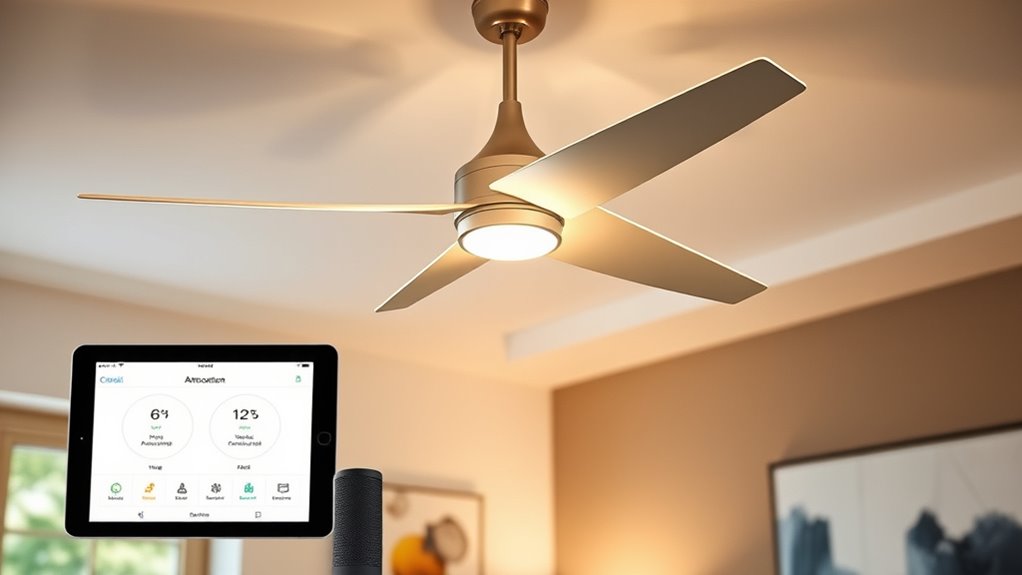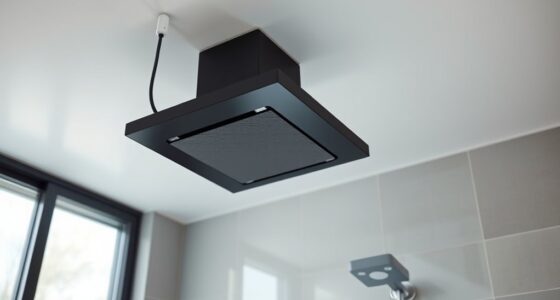Smart ceiling fans offer voice control, scheduling, and automation for effortless climate management. You can use virtual assistants like Alexa or Google Assistant to adjust fan speed, power, and settings hands-free, while scheduling features let you program operation times for comfort and efficiency. Automation responds to environmental factors such as temperature and occupancy, integrating smoothly with your smart home. Exploring these features further reveals how they enhance your home’s comfort and energy savings seamlessly.
Key Takeaways
- Voice control enables hands-free operation through virtual assistants like Alexa, Google Assistant, and Siri.
- Scheduling features allow programming fan operation based on time, temperature, or occupancy for automation.
- Sensors and environmental triggers let fans respond dynamically to temperature, humidity, sunlight, or presence.
- App-based controls provide remote access for adjusting settings, scheduling, and monitoring energy use from anywhere.
- Integration with smart home systems enhances convenience, energy efficiency, and overall household automation.

Have you explored how smart ceiling fans can enhance your home’s comfort and energy efficiency? These devices integrate advanced features that allow for seamless control, automation, and customization, making them a clever addition to modern households. Voice control is a key feature, enabling you to operate your fan hands-free through virtual assistants like Amazon Alexa, Google Assistant, or Apple Siri. This integration simplifies adjusting fan speed, turning the fan on or off, or changing settings without needing to access a physical switch or app. Voice commands are immediate and intuitive, providing convenience especially when your hands are occupied or when accessibility is a concern.
Scheduling is another essential aspect of smart ceiling fans, allowing you to program operational times based on your daily routines. You can set the fan to turn on or off at specific times, ensuring maximum comfort without manual intervention. For instance, scheduling the fan to activate shortly before you wake up or return home can improve comfort while reducing unnecessary energy consumption. Advanced scheduling options often include temperature-based triggers or integration with other smart home systems, further automating your environment to suit your preferences. This ensures that your home maintains a comfortable climate efficiently, avoiding the waste associated with manual operation or outdated timers.
Automation capabilities extend beyond simple scheduling by enabling your fan to respond dynamically to environmental conditions or other smart devices. For example, a smart ceiling fan can be configured to operate in conjunction with a smart thermostat, adjusting its speed based on room temperature or humidity levels. Some models also support geofencing, which detects your presence and activates or deactivates the fan accordingly. Furthermore, automation can incorporate sensors or routines triggered by external factors like sunlight or occupancy sensors, providing a tailored and energy-conscious experience. These systems reduce manual oversight, maximize comfort, and cut down on energy waste by ensuring the fan runs only when needed.
In addition to these features, many smart ceiling fans offer app-based control, giving you the ability to manage settings remotely from your smartphone or tablet. This flexibility enables adjustments from anywhere, whether you’re at work or on vacation. Some models also include energy usage monitoring, allowing you to track and analyze consumption patterns. This data can inform your habits, helping you identify ways to further reduce energy costs. Overall, the combination of voice control, scheduling, and automation transforms a traditional ceiling fan into a sophisticated component of your smart home, delivering enhanced comfort, efficiency, and convenience with minimal effort.
Frequently Asked Questions
Are Smart Ceiling Fans Compatible With All Smart Home Systems?
No, smart ceiling fans aren’t compatible with all smart home systems. You might think they would be, given their modern features, but many models work only with specific platforms like Alexa, Google Assistant, or Apple HomeKit. Before buying, check the fan’s compatibility. Otherwise, you might end up with a shiny device that refuses to integrate, leaving your smart home feeling a little less “smart” and a lot more frustrating.
What Is the Expected Lifespan of a Smart Ceiling Fan?
A smart ceiling fan typically lasts 10 to 15 years with proper maintenance. You should regularly clean the blades, check the motor, and replace worn-out parts to extend its lifespan. Using energy-efficient motors and high-quality components can also help it last longer. Keep the fan’s firmware updated for maximum performance. Proper installation and avoiding overuse will ensure you get the most out of your smart ceiling fan over the years.
How Secure Is Voice Control for Smart Ceiling Fans?
Voice control for smart ceiling fans is generally secure, but it depends on your setup. If you use strong, unique passwords and enable two-factor authentication on your smart home accounts, you reduce risks. Guarantee your Wi-Fi network has WPA3 encryption and keep firmware updated. Avoid sharing voice commands publicly, and disable voice control when not needed. These steps protect your device from unauthorized access and enhance overall security.
Can Smart Fans Be Controlled Remotely Without Internet?
Yes, you can control smart fans remotely without internet if they support local control options like Bluetooth or Zigbee. However, most rely on Wi-Fi, which requires an internet connection for remote access. Without internet, your control is limited to your local network. Make sure your fan has compatible protocols and the necessary apps installed. Otherwise, remote operation won’t be possible, leaving you confined to local commands.
What Is the Typical Installation Process for a Smart Ceiling Fan?
You start by turning off the power at the circuit breaker. Remove the existing ceiling fan and verify the ceiling box is compatible with your smart fan. Mount the fan’s mounting bracket, connect the wiring according to the manufacturer’s instructions, and secure the fan to the bracket. Finally, turn the power back on, install the remote or connect via app, and configure your fan’s settings for ideal operation.
Conclusion
Embracing smart ceiling fan features like voice control, scheduling, and automation subtly elevates your comfort and efficiency. These technologies seamlessly integrate into your daily routine, offering effortless control and energy savings. By choosing a smart ceiling fan, you’re gently steering towards a more convenient, connected living space. The future of home climate management quietly advances, making your environment smarter and your life easier—without disrupting the harmony of your home.









